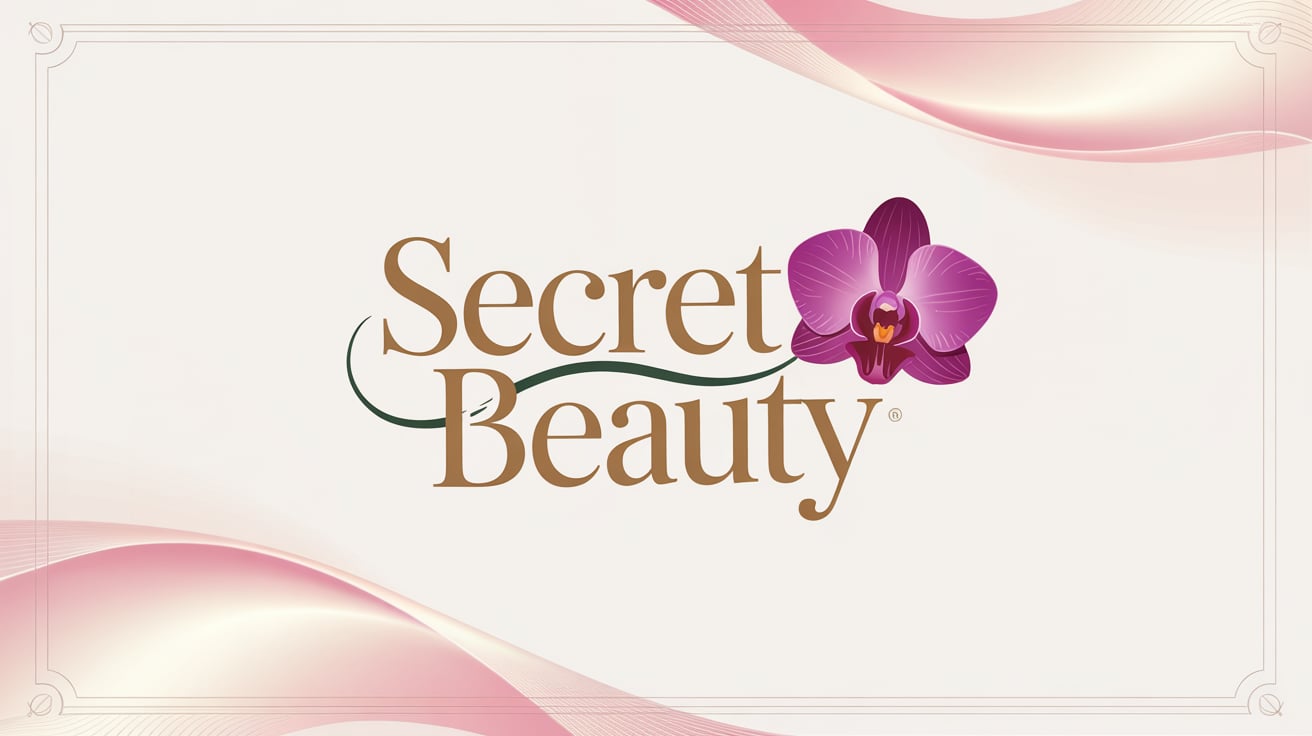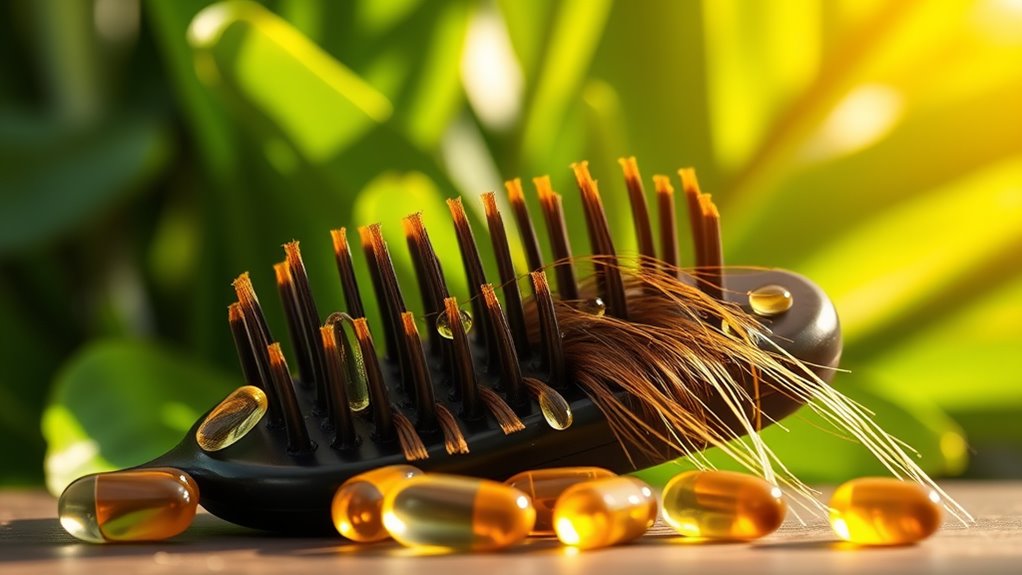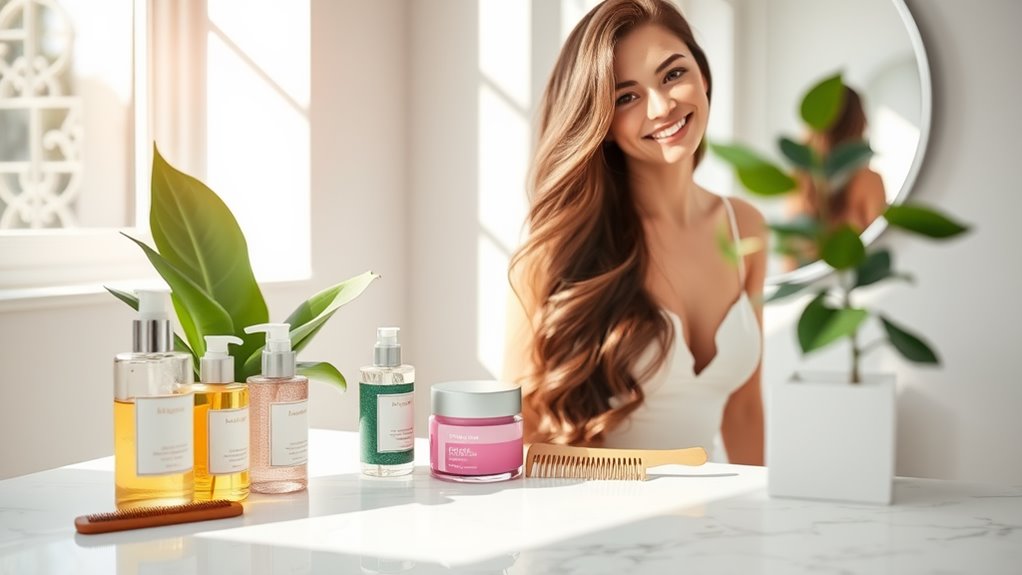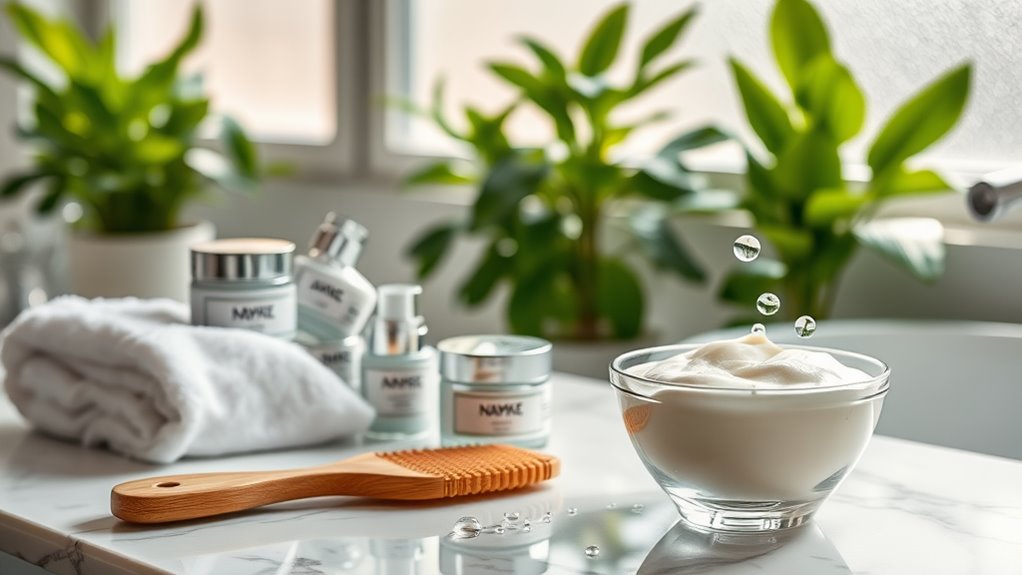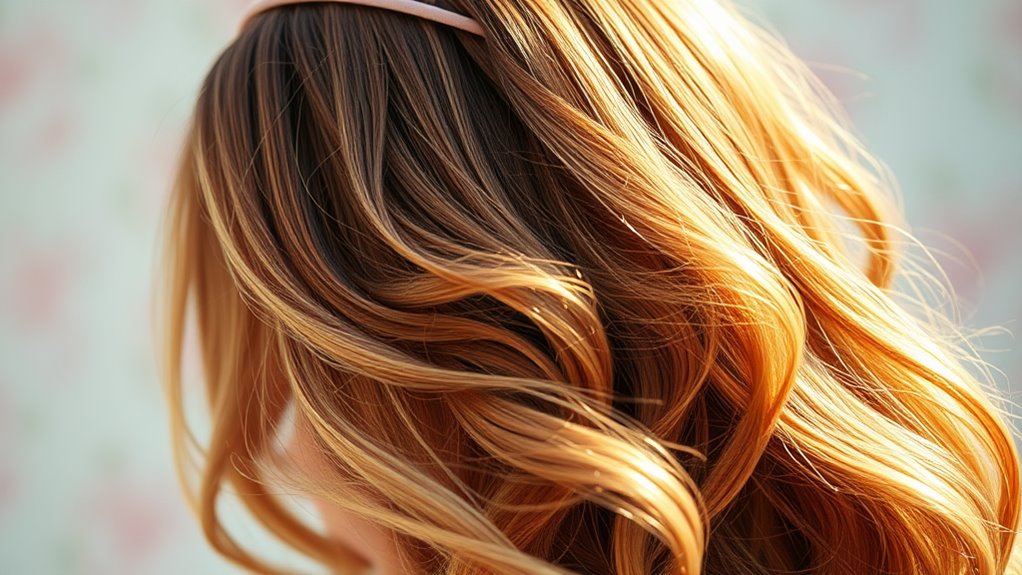Hair Routine That Made My Hair Feel Alive Again
To make your hair feel alive again, start by understanding your hair type and using the right products. Nourish your scalp with natural oils like jojoba or coconut oil. Maintain a healthy diet rich in proteins and vitamins to support growth. Choose sulfate-free shampoos and incorporate weekly deep conditioning treatments. Don’t forget heat protection while styling, and aim for regular trims to keep ends fresh. Keep adjusting your routine, and you’ll find what works best for your hair!
Key Takeaways
- Identify your hair type and porosity to select tailored products that nourish and enhance your hair’s natural texture.
- Maintain a balanced diet rich in protein, vitamins, and omega-3 fatty acids to support healthy hair growth from within.
- Incorporate weekly deep conditioning treatments and natural oils to restore moisture and improve hair manageability and shine.
- Use heat protection products before styling to minimize damage and schedule regular trims to eliminate split ends and promote healthier growth.
- Regularly assess your hair and scalp health, adapting your routine based on changes to ensure optimal care and vitality.
Understanding Your Hair Type
How well do you really know your hair type? Understanding your hair type is essential for crafting an effective routine that can truly revive hair.
Start by identifying whether your hair is straight, wavy, curly, or coily. Each type has unique needs; for instance, curly hair often craves moisture, while straight hair may need lightweight products to avoid greasiness.
Assess the thickness and porosity of your strands, too. Fine hair can easily become limp, while coarse hair might require richer treatments to stay vibrant. Additionally, knowing your hair’s porosity level can help in selecting the right products that penetrate or coat the hair effectively.
Once you grasp these characteristics, you’ll be equipped to choose the right products and techniques tailored to your hair’s specific needs.
Mastering the nuances of your hair type is the first step toward achieving luscious, healthy locks.
The Importance of a Healthy Diet
Eating a balanced diet is essential for maintaining healthy hair. Nutrients like vitamins and minerals support hair growth, while proper hydration keeps your scalp in top shape. Incorporating nutrient-packed foods into your meals can significantly enhance hair strength and vitality.
Nutrients for Hair Growth
While you might focus on external treatments for your hair, the nutrients you consume play an indispensable role in its growth and overall health. A diet rich in vitamins and minerals can greatly enhance your hair’s vitality.
Incorporate plenty of protein, as hair is primarily made of keratin, a protein. Iron and zinc are also crucial; they support circulation and nutrient delivery to hair follicles. Omega-3 fatty acids found in fish and nuts promote scalp health, while biotin is known for preventing hair loss.
Don’t overlook vitamins A, C, and E, which protect against oxidative stress. By prioritizing these nutrients, you’re setting the foundation for lush, resilient hair that radiates life and beauty.
Hydration and Scalp Health
Although you may focus on external products for your hair, hydration is just as essential for maintaining a healthy scalp and promoting hair growth. To achieve ideal results, you need to nourish your body from within.
Drinking enough water daily keeps your scalp hydrated, preventing dryness and flakiness. Incorporating foods rich in omega-3 fatty acids, like salmon and flaxseeds, can also enhance your scalp’s moisture barrier.
Additionally, vitamins A, C, and E play vital roles in scalp health by supporting sebum production and promoting circulation.
Don’t underestimate the power of antioxidants found in fruits and vegetables, as they combat inflammation. By prioritizing a balanced diet, you’re setting the foundation for vibrant, resilient hair.
Make these changes, and watch your hair thrive.
Choosing the Right Shampoo and Conditioner
When it comes to maintaining healthy hair, selecting the right shampoo and conditioner is essential.
Start by understanding your hair type and specific needs. Consider the following factors:
-
Ingredients: Look for sulfate-free and paraben-free formulas to avoid stripping natural oils.
-
Hair Type: Choose products designed for your hair’s unique texture, whether it’s curly, straight, or wavy.
-
Scalp Condition: If you have an oily or dry scalp, select a shampoo that addresses these issues specifically.
-
Purpose: Identify your hair goals, whether it’s moisture, volume, or repair, and match products accordingly. Additionally, nurturing your scalp is crucial for creating a healthy environment that promotes natural hair growth.
Weekly Deep Conditioning Treatments
To keep your hair looking vibrant and healthy, incorporating weekly deep conditioning treatments into your routine is essential.
Choose a product that aligns with your hair type and specific needs—whether it’s hydration, repair, or nourishment. Apply the treatment generously, focusing on the mid-lengths to ends where damage is often more pronounced.
Allow it to penetrate for at least 20-30 minutes; consider using a heat cap to enhance absorption. Rinse thoroughly to remove any residue, leaving your hair soft and revitalized.
Regular treatments help restore moisture balance, reduce breakage, and improve overall manageability. You’ll notice increased shine and elasticity, making styling easier and more enjoyable. Additionally, following a weekly hair mask routine can significantly amplify the benefits of your deep conditioning treatments.
Commit to this weekly ritual, and your hair will thank you!
Incorporating Natural Oils Into Your Routine
Incorporating natural oils into your hair care routine can greatly enhance its health and appearance.
These oils provide nourishment, moisture, and protection, ensuring your hair looks vibrant and feels alive. Here’s how to make them work for you:
-
Coconut Oil: Penetrates the hair shaft, reducing protein loss and increasing shine.
-
Argan Oil: Rich in antioxidants, it hydrates and smooths frizz while adding a luxurious sheen.
-
Jojoba Oil: Mimics natural scalp oils, balancing moisture and preventing dryness.
-
Olive Oil: Strengthens hair and promotes elasticity, making it less prone to breakage.
Incorporate these oils by applying them as pre-wash treatments, leave-in conditioners, or styling aids. Additionally, using oils that are known to stimulate follicle health can further contribute to promoting faster hair growth.
Your hair will thank you!
Scalp Care: Techniques for Healthy Growth
Taking care of your scalp is essential for promoting healthy hair growth.
Regular exfoliation can help remove buildup and improve circulation, while essential oils can nourish and invigorate your scalp.
Exfoliation for Scalp Health
While many focus on hair care products, exfoliating your scalp is essential for promoting healthy hair growth. By removing dead skin cells and buildup, you create a clean environment for your hair follicles to thrive.
Here are some effective techniques to incorporate into your routine:
-
Use a scalp scrub****: Choose one with natural exfoliants to gently buff away impurities.
-
Massage regularly: Increase blood circulation by using your fingertips to massage your scalp while washing.
-
Try a DIY treatment****: Mix sugar or sea salt with your shampoo for a natural exfoliation boost.
-
Schedule weekly exfoliation****: Commit to exfoliating your scalp at least once a week to maintain peak health.
Master these techniques, and watch your hair flourish like never before!
Essential Oils Benefits
After ensuring your scalp is free from buildup, exploring the benefits of essential oils can greatly enhance your hair care routine.
These concentrated plant extracts offer a variety of advantages for scalp health. For instance, tea tree oil combats dandruff and soothes irritation, while lavender oil promotes relaxation and improves circulation. You can also use rosemary oil to stimulate hair growth by invigorating hair follicles.
To incorporate these oils, dilute a few drops in a carrier oil like jojoba or coconut oil, then massage it into your scalp. This technique not only nourishes your roots but also encourages healthy growth.
Consistent use can transform your scalp, making it a thriving environment for luscious hair. Embrace these powerful allies in your journey to vibrant hair!
Heat Protection and Styling Tips
To keep your hair healthy amidst styling, it’s essential to use heat protection products before you pick up that curling iron or flat iron. These products form a barrier, shielding your strands from damage.
Here are some tips to master your heat styling routine:
-
Choose the right heat protectant****: Look for products suited to your hair type, ensuring maximum protection.
-
Apply evenly: Distribute the product from roots to tips for consistent coverage.
-
Use the right temperature: Adjust your styling tools to the appropriate heat setting based on your hair’s thickness and condition.
-
Limit heat exposure: Aim for fewer styling sessions per week to minimize damage.
Regular Trims and Maintenance
Regular trims are crucial for maintaining healthy hair, as they prevent split ends and breakage from traveling up the hair shaft. When you commit to regular maintenance, you’re fostering an environment where your hair can thrive.
Aim for a trim every six to eight weeks, depending on your hair type and growth rate. This routine not only removes damaged ends but also encourages your strands to grow stronger and shinier.
Don’t underestimate the power of a skilled stylist; their expertise can elevate your look and guarantee your hair remains in top condition.
Tracking Your Progress and Adjusting the Routine
Tracking your progress is essential for achieving healthy hair, and it helps you fine-tune your routine as needed.
Start by regularly evaluating your hair’s condition and noticing any changes. This proactive approach empowers you to adapt your regimen effectively.
Here are some key aspects to monitor:
- Hair texture: Is it feeling softer or rougher?
- Shine levels: Are you noticing more luster or dullness?
- Breakage and split ends: Are these decreasing or increasing?
- Scalp health: Is your scalp feeling less itchy or flaky?
Frequently Asked Questions
How Long Does It Take to See Results From a Hair Routine?
It typically takes about four to six weeks to see noticeable results from a hair routine. Consistency’s key; stick with it, and you’ll start noticing healthier, shinier hair as your routine takes effect.
Can I Use the Same Routine for Different Hair Types?
You can use the same routine for different hair types, but you’ll need to adjust products and techniques. Pay attention to your hair’s unique needs to optimize the results and achieve your desired look.
What Should I Do if My Hair Feels Greasy?
If your hair feels greasy, start by washing it more often with a clarifying shampoo. You can also try dry shampoo between washes and avoid heavy products that can weigh your hair down. Adjust your routine accordingly.
How Often Should I Wash My Hair?
You should wash your hair every two to three days, depending on your hair type and lifestyle. If it feels greasy or heavy, consider adjusting the frequency to maintain a fresh, healthy look.
Are There Specific Products to Avoid for Damaged Hair?
When dealing with damaged hair, avoid sulfates, alcohols, and harsh chemicals. These ingredients can strip moisture and weaken strands further. Instead, opt for gentle, nourishing products that promote healing and restoration for healthier hair.
